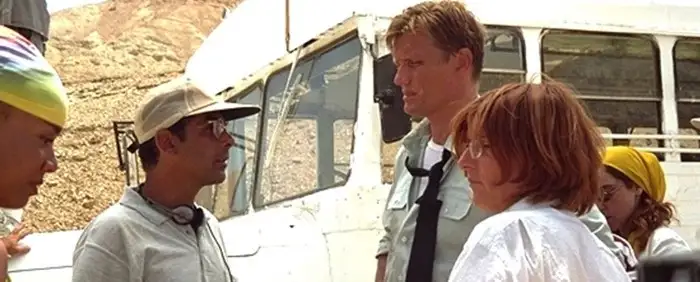You also directed a military-style film with Dolph Lundgren, The Last Warrior (aka The Last Patrol).Now, that was a script that I didn’t write. It was not a good script. I had written another screenplay called
Hell on Wheels, which is about these military dune buggies that were used in the first Gulf War. It got optioned by Largo Entertainment, and Largo got me in touch with a producer named Jacob Kotzky, who was Israeli. Israel was the perfect place to shoot this movie, because they had a lot of captured Soviet equipment. And Saddam Hussein was using Soviet equipment. Basically, this is during the Cold War. So, the Soviets were supplying Saddam Hussein with military equipment. The Soviets were supplying the Syrians, the Jordanians, and the Egyptians with Soviet-made hardware. And once the Americans got into the game, they were supplying the Israelis with American-made stuff. So, they had a few horrendous wars over there, and the Israelis ended up capturing a lot of this Soviet equipment. They had a bunch of [this old equipment available].
They had all the goodies, all the Soviet tanks — all of that stuff. So, we were going to do [
Hell on Wheels] over there. It would’ve been a perfect place to shoot the movie because it was desert, it looks just like Iraq. [But] Jacob could not raise a sufficient budget to shoot it. It was a big movie with big battle scenes. He did have some money raised and he still wanted to make a film. He had made a movie [earlier] with Dolph Lundgren in Israel called
Cover Up. [So,] he got in touch with Dolph, and Dolph was interested. Jacob found a script called
The Last Patrol, which was written by a couple of people who basically had only written soap operas before. These were not action writers.
I just didn’t think the script was good, but I liked the idea of shooting a movie in Israel and working with Dolph Lundgren. That all sounded good to me, so I signed up for that. And same with Dolph, Dolph wanted to work with me. Neither one of us liked the script, but I told him I would fix up the script, and I certainly had the credentials for fixing up an action movie.

And so, that was the plan. But then, when I got over there, the writers were also producers on the movie, and they said, “Oh no, you’re not touching a word of our precious [script]. Okay. You’ve got to shoot this script the way it is”. They also threatened to fire me. They said, “If you change anything, we’re going to fire you. We’re going to get somebody else to do this”. Because they thought their script was brilliant. Well, it wasn’t. Dolph pretty much felt the same way. Well, look, we’re in Israel already, let’s just shoot this damn thing and make the best of it.
[To be fair,] these two writers were actually pretty good when it came to dialogue. There was a lot of dialogue in the movie. One thing I found about Dolph was that he could memorize dialogue. We did a few scenes that were two pages long, so, we’re talking about two minutes of screen time. And I shot these scenes without a cut. I did get some coverage in case I wanted to cut in, but I didn’t need to. Dolph could pretty much play an entire scene, an entire two-minute scene, and not miss a beat and get every word perfect. And even though he was born in Sweden, he worked on his accent, and he sounded like an American. You see the movie, you wouldn’t know that he was from a foreign country. I was pretty damn impressed with Dolph Lundgren, and he was very easy to work with. We did our best with that one.
Sometimes that’s all you can do. You do the best you can with what you’re given.I brought my family over there, to Israel. So, I wasn’t about to say, “Okay, I’m pulling the plug on everything. You’ve all got to go home. All right. Forget about being in Israel.” I liked being there, too, and I had some relatives that were living there. We made the best of it, and I must say I had a really good time working on that movie. But just because I had a good time working on it, doesn’t mean the movie itself turned out good.
I had some pretty rough times making
Double Impact, for example. That was a really long, tough shoot. You can get all the details in the book — a lot of personalities that weren’t getting along with one another, and logistical problems. We were supposed to shoot the entire movie in Hong Kong, and because there was so much bickering between the various producers, we decided to move the entire production back to the US. During the Christmas and New Year’s break, we basically packed up and moved back to LA, and shot a good portion of the movie in Los Angeles, which you certainly can’t tell, if you watch the movie, it looks like the whole thing was shot in Hong Kong.
We had a terrific production designer who designed and built some sets [to create that illusion]. There’s a scene where Chad and Frank first arrive in Hong Kong and they’re driving down the streets in the Mong Kok district, and then, they get out of their van, and they go inside this bar where Frank knows that they’re going to find Alex. They’re in the street, and they go inside, and then, we cut. And now, we’re inside a mahjong parlor. Well, that mahjong parlor was in LA, that was a set — just a perfect transition.





